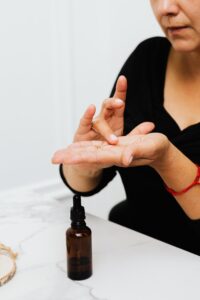Expert Advice
![]()
Retinol, a derivative of vitamin A, is a powerhouse ingredient celebrated for its ability to improve skin texture, reduce fine lines, and promote a youthful complexion. However, for some individuals, retinol can have an unfortunate side effect: acne. If you’re experiencing breakouts or worsening of acne since incorporating retinol into your skincare routine, fear not! In this blog, we will explore the causes of acne triggered by retinol and provide effective strategies to manage and prevent these unwanted breakouts. With the right approach, you can enjoy the benefits of retinol while maintaining clear, blemish-free skin.
Understanding Acne Triggered by Retinol:
-
Retinol Purging vs. Breakouts:
When starting a retinol regimen, it’s crucial to differentiate between retinol purging and actual breakouts. Retinol purging is a temporary phase where existing clogged pores are brought to the surface, resulting in an initial increase in breakouts. This is a normal reaction as retinol accelerates skin cell turnover. However, if you notice persistent and new breakouts beyond the purging period, it may indicate that retinol is triggering acne.
-
Causes of Acne Triggered by Retinol:
a) Increased Cell Turnover: Retinol speeds up the exfoliation process, which can lead to an increased shedding of dead skin cells. If not properly removed, these cells can clog pores and contribute to acne formation.
b) Dryness and Irritation: Retinol can cause dryness and irritation, disrupting the skin’s natural moisture balance. Dry, flaky skin can trap oil and bacteria, leading to clogged pores and acne breakouts.
c) Comedogenic Ingredients: Some retinol products contain comedogenic ingredients that can clog pores and contribute to acne. It’s essential to choose non-comedogenic formulations to minimize the risk of breakouts.
Strategies for Managing Acne Triggered by Retinol:
-
Start Slow and Gradual:
Begin by using retinol products in lower concentrations and gradually increase the frequency and strength over time. This allows your skin to adjust to the retinol and minimizes the risk of irritation and breakouts.
-
Hydrate and Moisturize:
Counteract the drying effects of retinol by prioritizing hydration and moisturization. Opt for lightweight, non-comedogenic moisturizers that provide ample hydration without clogging pores. Consider incorporating humectant ingredients like hyaluronic acid to boost skin hydration levels.
-
Protect and Soothe:
Apply a broad-spectrum sunscreen daily to protect your skin from harmful UV rays, as retinol can increase sun sensitivity. Additionally, use soothing and calming ingredients like aloe vera, chamomile, or niacinamide to alleviate any irritation or redness caused by retinol.
-
Adjust Your Skincare Routine:
Reevaluate your skincare routine and ensure it complements your retinol usage. Avoid using harsh or abrasive exfoliants that can further irritate your skin. Instead, focus on gentle cleansers and non-abrasive exfoliating agents, such as chemical exfoliants like AHAs or BHAs, to maintain a healthy skin barrier.
-
Spot Treat Breakouts:
If you experience breakouts in specific areas, consider spot treating with acne-fighting ingredients like benzoyl peroxide or salicylic acid. Be cautious not to overdo it or combine too many active ingredients, as this can lead to further irritation and dryness.
-
Consult a Dermatologist:
If your acne persists or worsens despite following these strategies, it’s advisable to consult a dermatologist. A dermatologist can assess your skin condition, evaluate the specific triggers of your acne, and recommend appropriate treatment options. They may suggest alternative retinoids or combination therapies that can address your acne concerns while minimizing potential side effects.

-
Consider Buffering:
Buffering is a technique that involves applying moisturizer before or after applying retinol to reduce its potency and minimize potential irritation. This can be especially beneficial for individuals with sensitive or acne-prone skin. However, it’s essential to follow the specific instructions provided by the retinol product and consult with a skincare professional if needed.
-
Patience and Persistence:
Managing acne triggered by retinol requires patience and persistence. It’s crucial to remember that everyone’s skin is unique, and finding the right balance and routine may take time. Stay committed to your skincare regimen, monitor your skin’s response, and make adjustments as necessary.
Preventing Acne Breakouts:
Prevention is key when it comes to managing acne triggered by retinol. Consider these preventive measures:
- Patch Test: Before incorporating a new retinol product into your routine, perform a patch test on a small area of skin to check for any adverse reactions.
- Choose the Right Formulation: Opt for retinol products specifically designed for acne-prone or sensitive skin. Look for labels that indicate non-comedogenic and fragrance-free formulas.
- Gradual Introductions: Introduce new skincare products one at a time, allowing your skin to adapt and respond. This approach helps identify any potential triggers and allows for a better understanding of how your skin reacts.
- Maintain Consistency: Consistency is key with retinol. Use it regularly as directed to achieve the desired results while minimizing potential breakouts.
Conclusion:
Managing acne triggered by retinol requires a thoughtful and individualized approach. By understanding the causes of acne, adjusting your skincare routine, and incorporating preventive measures, you can enjoy the benefits of retinol without the unwanted breakouts. Remember to be patient, listen to your skin, and consult with a dermatologist if necessary. With the right strategies and a tailored skincare regimen, you can achieve clearer, healthier skin while harnessing the transformative power of retinol.

